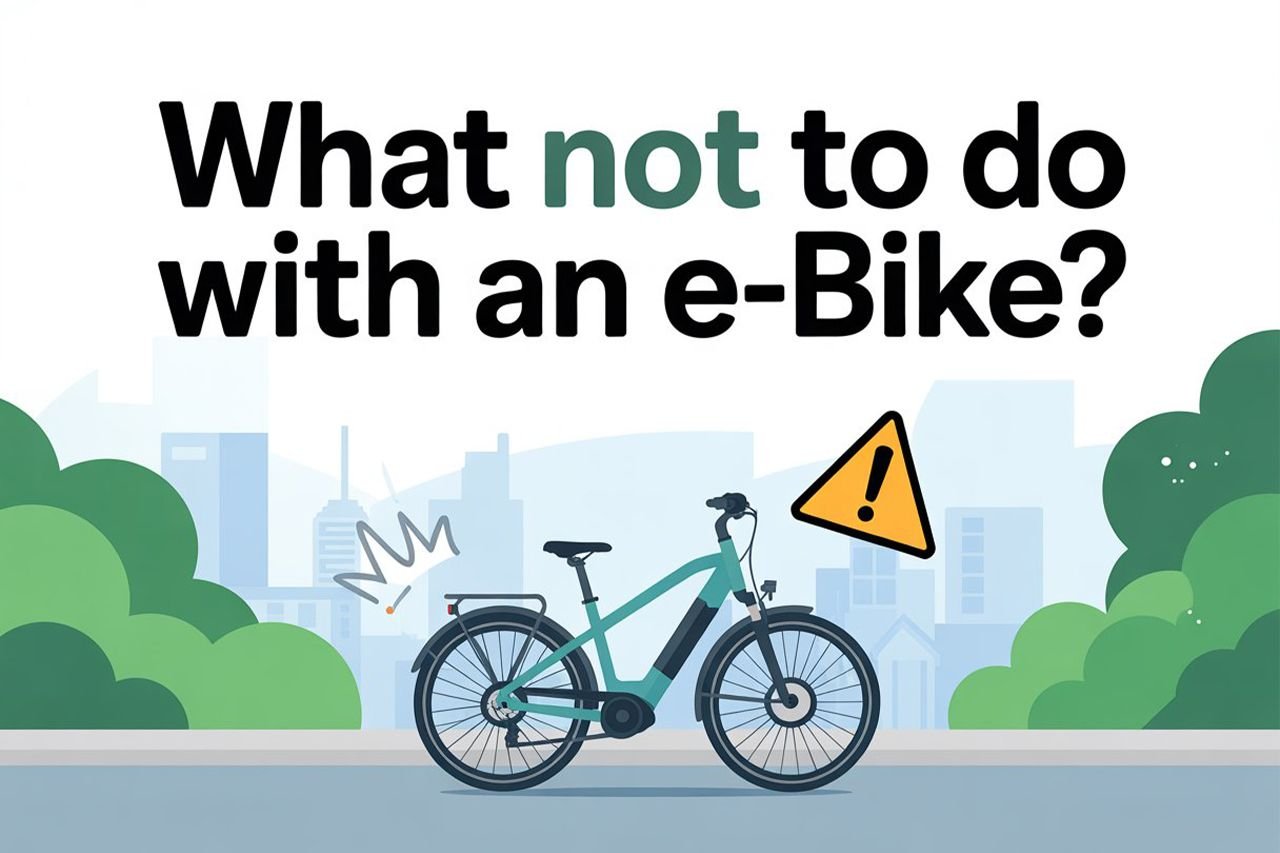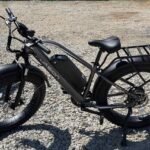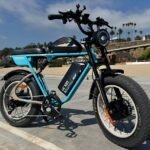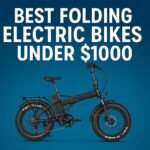
E-bikes are fantastic—they can totally change your commute and make weekends a lot more fun. But, like with any powerful gadget, things can go wrong fast (and get expensive) if you aren’t careful.
Some of the biggest e-bike blunders? Ignoring the manual, skipping maintenance, overloading the bike, messing up with the battery, riding unsafely, and letting your bike take a beating from the elements. These slip-ups can cause accidents, pricey repairs, or even leave you with a dead bike.
This guide digs into the most common e-bike mistakes and how to dodge them. We’ll talk about battery care, safer riding, and the kind of maintenance that actually keeps your e-bike rolling for the long haul.
1. Ignoring Manufacturer Guidelines
Every e-bike comes with a manual that’s based on actual testing, not just legal stuff. People who skip reading it usually end up with surprise repairs, safety problems, and voided warranties. All that hassle for nothing, honestly.
Selecting the Wrong Type of Ebike
Not all e-bikes are the same, and picking the wrong kind can get frustrating or even sketchy. Too many folks buy whatever looks cool without thinking about where or how they’ll actually ride.
Commuter e-bikes are built for pavement and maybe some light gravel. They’re usually lighter, with narrower tires—not meant for wild trails.
Mountain e-bikes have beefy suspension and fat tires for rough ground. Using one for city commutes? Honestly, it’s overkill, plus you’ll drain your battery way faster.
Cargo e-bikes are heavy-duty, made for hauling big loads. If you’re not carrying much, they just feel bulky and cost more than they should.
Quick cheat sheet on e-bike types:
| Ebike Type | Best For | Avoid Using For |
|---|---|---|
| Commuter | City streets, bike paths | Mountain trails, heavy cargo |
| Mountain | Off-road trails, hills | Long commutes, cargo hauling |
| Cargo | Deliveries, families | Racing, technical trails |
| Folding | Storage, travel | Heavy-duty use, long rides |
Misunderstanding Ebike Specifications
Specs aren’t just sales talk—they matter for safety and how your ride feels. Too often, people obsess about speed or range and forget about things like weight limits or motor size.
Weight limits are there for a reason. If you go over, you risk breaking stuff and making the bike dangerous. Most e-bikes are rated for 250-300 pounds, including you and your gear.
Motor power matters more than you’d think. A 250-watt motor is fine for flat cities, but if you’ve got hills, you’ll want 500-750 watts. Too little power, and you’ll just burn through your battery and curse every slope.
Battery capacity (watt-hours, or Wh) can be misleading. A 400Wh battery won’t get you as far if you’re heavy, ride fast, or climb hills. Don’t expect miracles from a small battery.
Class ratings affect where you can actually ride. Class 1 and 2 bikes usually get you on most bike paths, but Class 3? More rules, more headaches.
Using Unapproved Parts or Accessories
Manufacturers design e-bikes with specific parts for a reason. Swapping out components can make things unsafe or mess with your warranty. It’s easy to think a “simple” mod won’t matter, but it really can.
Batteries are especially risky. Cheap generics might not have the right safety features. Worst case? You could end up with a fire or a fried controller.
Chargers need to match your battery. The wrong one can overcharge cells, kill your battery, or even start a fire. Stick to what the manual says for charging—it’s not worth the risk.
Tires take a beating on e-bikes. Regular bike tires just don’t cut it for the extra weight and speed. You want grip and durability, not flats and skids.
Brakes need to be up for the job, too. E-bikes are heavier and faster, so you can’t just slap on any old brake system and hope for the best.
Some common mods that cause headaches:
- Throwing in bigger batteries without beefing up the controller
- Adding throttles to pedal-assist-only bikes
- Taking off speed limiters (seriously, don’t)
- Using car parts instead of bike-specific gear
2. Skipping Regular Maintenance
Keeping up with maintenance is what keeps you safe and your e-bike out of the shop. Ignore it, and you’re basically asking for breakdowns, big repair bills, and a bike that wears out way too soon.
Neglecting Tire Pressure Checks
Let’s be real—most people forget about tire pressure. But if you let your tires run low, you’ll ruin your ride and your bike.
Low tires make the motor work harder, so you drain your battery faster. Plus, your tires wear out way quicker from all that extra friction.
Recommended tire pressures:
- Road e-bikes: 80-130 PSI
- Hybrid e-bikes: 50-70 PSI
- Mountain e-bikes: 25-35 PSI
- Fat tire e-bikes: 5-15 PSI
Just check your tire pressure once a week. A cheap pressure gauge is all you need—it’ll save you money and headaches later.
Forgetting Brake and Light Inspections
Bad brakes on an e-bike? That’s a disaster waiting to happen. E-bikes weigh more and go faster, so you need brakes that actually work.
People usually notice their brakes only when they fail. By then, pads are gone and rotors might be toast.
Quick brake check:
- Squeeze the levers—they should feel solid
- Look at the pads for wear
- Check for leaks if you have hydraulic brakes
- Test your brakes at slow speeds
Lights matter just as much. If they’re dead, cars won’t see you. Most e-bike accidents? Drivers just didn’t spot the rider.
It’s smart to check your lights before every ride. Keep spare batteries or charge up—just don’t leave it to chance.
Overlooking the Drivetrain
Your chain, gears, and derailleurs work overtime on an e-bike. All that extra power means more wear and tear.
A dirty chain doesn’t shift right and saps battery power. Dirt and grit add friction, making your motor sweat for every mile.
Chains also stretch faster on e-bikes. If you ignore it, you’ll get skipping gears and, eventually, a broken chain.
Weekly drivetrain care:
- Wipe the chain with a rag
- Lube it after cleaning
- Check for stretch with a chain checker
- Listen for weird grinding or clicking
Chains are cheap to replace ($20-40). If you let it go, you’ll wreck the cassette and chainrings—which is way pricier.
Ignoring Professional Servicing Recommendations
Some stuff just needs a pro. E-bike maintenance sometimes means dealing with electronics and diagnostics you can’t do at home.
Batteries need special tools to check health. Bike shops can spot trouble before your battery totally dies.
Motor firmware updates also need a shop. They fix glitches and boost performance. Most people don’t have a clue how to do that safely.
Annual pro tune-up:
- Full electrical system check
- Battery health test
- Motor firmware update
- Brake bleeding (for hydraulics)
- Wheel truing and spoke tension
Professional tune-ups run $75-150 a year. It’s worth it—major repairs can cost five times that. Book maintenance before you run into trouble.
3. Overloading and Improper Cargo Handling
Hauling too much or loading your stuff wrong can wreck your e-bike and make riding risky. Bad cargo habits also suck up battery life and can cause spills.
Exceeding Manufacturer Weight Limits
Every e-bike has a maximum total weight (you plus your cargo). Most can handle 250-400 pounds, tops.
If you go over, you’ll stress the frame, wheels, and brakes. The motor works overtime, and your battery drains faster. Just because there’s a motor doesn’t mean you can pile on more weight—it’s not magic.
Typical weight limits:
- Commuter: 250-300 lbs
- Cargo: 300-400 lbs
- Mountain: 275-350 lbs
- Folding: 220-280 lbs
Too much weight can crack the frame, bend wheels, and make stopping harder. Always check your manual for the real limit.
Carrying Unbalanced Loads
If you put all your stuff on one side, your bike gets wobbly and tough to steer. Hanging heavy bags from one handlebar or loading unevenly is a recipe for trouble.
Loads that are too far forward mess up your steering and can flip you when you brake. Rear-heavy loads lift your front wheel, making it hard to control.
Best bet? Spread out the weight. Keep heavy stuff low and centered. Don’t hang anything heavy from the bars—just don’t.
How to load cargo better:
- Use panniers on both sides
- Put heavy items in the middle of rear racks
- Keep cargo below seat height if you can
- Strap everything down so it doesn’t shift
Using Inadequate Racks or Storage Solutions
Cheap or poorly designed racks break under normal loads and can cause accidents. Some riders grab racks that just aren’t made for their specific e-bike model, hoping for the best.
E-bikes need stronger racks than regular bikes. They’re heavier and faster, so the mounting points take a beating. Generic racks usually don’t fit right, and that’s just asking for trouble.
Buy racks rated for your e-bike’s weight. Look for models built for electric bikes, not just “universal” ones. They should bolt on solidly and stay clear of your battery and motor.
Bungee cords and rope? Nope. They’re not enough to keep cargo safe. Use proper straps, clips, or panniers made for bikes. Otherwise, loose stuff can bounce into your wheels or chain—hello, crash.
4. Careless Ebike Battery Management
Bad battery habits are a quick way to ruin an expensive ebike. Simple mistakes—like charging in extreme temperatures or running the battery down to zero—can cost you hundreds in replacements.
Charging in Unsafe Conditions
Lots of ebike owners just plug in wherever’s convenient. Honestly, that can go sideways fast.
Temperature matters way more than most folks realize. Charging your battery in extreme heat or cold can mess up the cells for good. Aim for around 70°F if you can.
Hot garages, car trunks, attics—just don’t. Same goes for freezing basements or outside in winter. If the battery feels too hot or cold to touch, give it time to warm up or cool down before charging.
Proper ebike battery care means keeping batteries dry while charging. Wet or damp spots can cause shorts or corrosion.
Key charging safety rules:
- Charge only on hard surfaces (never on carpet or furniture)
- Keep flammable stuff away from your charger
- Check for damage before plugging in
- Don’t leave basic chargers unattended
Allowing Complete Discharge
Running your battery down to empty is about the worst thing you can do. Lithium-ion batteries hate being drained to zero.
Most ebikes shut off before true zero, but some riders ignore the warnings and push their luck. That’ll shrink your battery’s capacity for good.
The 20-80 rule is your friend. Keep your battery between 20% and 80% most days. Only charge to 100% if you really need the range.
Plan your rides so you’re not running on fumes. Charge up before you dip below 20%—don’t wait for the emergency shutdown.
Using Third-Party Chargers
It’s tempting to grab any charger that fits, especially if you lose the original. But honestly, it’s a gamble that rarely pays off.
Not all ebike chargers are created equal—even if they look the same. Different batteries need different voltages and charging profiles. Using the wrong charger can fry your battery management system.
Good ebike batteries “talk” to their matching chargers. They swap info about temperature, voltage, and condition. Third-party chargers? They’re not having that conversation.
Replacement charger guidelines:
- Get exact replacements from the manufacturer if you can
- Contact the ebike company before using a substitute
- Don’t assume lookalike chargers are safe
- Double-check voltage and amperage ratings
Storing Battery Improperly
Parking your ebike and forgetting about the battery kills it faster than years of riding. Out of sight, out of mind—until it’s dead.
The 50% rule saves batteries in storage. Charge to about half before putting your bike away for a month or more. That keeps the cells from deep discharge and lowers stress.
Temperature is just as important when storing. Hot garages and freezing sheds are battery graveyards. Room temp is best for long life.
Batteries need a little exercise, too. Give them a charge and discharge cycle every few months, even if you’re not riding. Keeps the cells happy.
Storage best practices:
- Store at 50% charge in a cool, dry place
- Check battery level monthly if it’s sitting for a while
- Take the battery off the bike for winter storage
- Keep terminals clean and protected from corrosion
5. Unsafe Riding Habits
Bad habits on your ebike can turn a fun ride into a mess. Speeding, skipping safety gear, and ignoring traffic rules—these are the big mistakes that put you at real risk.
Ignoring Speed Limits
Some riders think faster is always better, but that’s a recipe for disaster. Class 3 ebikes can hit 28 mph, which is way quicker than most folks expect.
It’s not just about breaking the law. Higher speeds mean it takes longer to stop and you’ve got less time to react. If you punch the throttle without the practice, you might lose control.
Common Speed-Related Mistakes:
- Cranking pedal assist to max right away
- Gunning full throttle from a stop
- Blasting top speed in crowded places
- Forgetting to slow down for bad weather
Start with low pedal assist and build up your skills. In the city, you rarely need to go full tilt—save the speed for open stretches where it’s actually safe.
Riding Without Proper Safety Gear
Skipping safety gear is like betting your brain on a coin toss. You can’t fix a bad head injury the way you can a scraped elbow.
Your helmet should be CPSC certified and from a legit shop. If you want extra peace of mind, look for the NTA 8776 e-bike standard. That’s real protection for higher speeds.
Helmets matter, but so does being seen. Visibility gear can save your life when drivers don’t expect a bike flying by at 25 mph.
Essential Safety Equipment:
- CPSC-certified helmet (seriously, don’t skip this)
- High-vis clothing or a reflective vest
- Working front and rear lights
- Bright colors—ditch the all-black look
Some folks think safety gear looks goofy, but honestly, a hospital gown is worse. Plus, new gear actually looks pretty slick.
Disregarding Traffic Laws
Traffic laws aren’t just for cars. If you blow through stop signs, run red lights, or skip hand signals on your ebike, you’re risking everyone’s safety—yours included.
Drivers often don’t expect bikes to move this fast. If you don’t signal clearly, they can’t guess your next move.
Critical Traffic Rules for E-bike Riders:
- Stop fully at stop signs and red lights
- Use hand signals before turning
- Ride with the flow, not against traffic
- Yield when you’re supposed to
Ride defensively. Assume others will mess up. Even if you’ve got the right of way, double-check before crossing. A few seconds of caution beats a lifetime of regret.
6. Risky Environmental Practices
Environmental hazards can wreck your ebike’s battery, electronics, and frame. Extreme temps, water, and sunlight are the big ones that’ll leave you with a hefty repair bill.
Riding or Storing in Extreme Temperatures
Cold weather is brutal on ebike batteries. Lithium-ion cells lose up to 40% of their juice when it drops below 32°F (0°C). Shorter rides, maybe even getting stranded—no fun.
Hot weather—above 95°F (35°C)—can be just as rough. Sometimes the battery management system shuts things down to avoid frying itself. You’re left pedaling without any help.
Temperature Storage Guidelines:
- Ideal range: 32-77°F (0-25°C)
- Never store below: 14°F (-10°C)
- Never store above: 104°F (40°C)
- Humidity: 45-85%
Cold also drops tire pressure—about 1-2 PSI for every 10°F down. Squishy tires mean more rolling resistance and faster battery drain.
Submerging in Water or Exposing to Heavy Moisture
Most ebikes have IP ratings between IP54 and IP67. That’s fine for light rain, but forget about dunking them. Water damage to the electronics can run you $500-$1,500 to fix.
The battery compartment is especially at risk. Water causes shorts, corrosion, and can ruin the cells. Even a little moisture can rust your components.
Ride through deep puddles and you might soak the motor. Water sneaks into the housing, fries the electronics, and usually voids your warranty.
Water Exposure Risks:
- Shorted battery
- Motor failure
- Display glitching out
- Corroded brakes
Leaving Your Ebike in Direct Sunlight
UV rays and heat from the sun break down rubber and fade paint. The battery really hates heat from baking in direct sunlight.
Park your ebike outside on a 90°F day and the inside can hit 140°F or more. That cooks the battery, speeds up aging, and can trigger a thermal shutdown.
The LCD screen can get ruined by UV, too. Leave your bike out all summer and you might come back to a display you can’t read.
Rubber grips and dashboard parts get brittle and crack if you leave them in the sun. That might not sound huge, but it hurts resale value and just feels lousy to use.
Final Thoughts
Honestly, taking care of an ebike isn’t rocket science. Dodging the usual mistakes can save you a ton on repairs, though—nobody wants to drop cash on something that could’ve been avoided.
Batteries? That’s where most folks slip up. Some forget to charge them right, or just leave them baking in the sun (or freezing in the garage). It’s wild how fast a $500 battery can die if you treat it wrong—sometimes just a few months.
Key Ebike Don’ts:
- Don’t skip tire pressure checks
- Don’t ride in heavy rain without some protection
- Don’t stash the battery when it’s totally drained
- Don’t ignore regular cleaning
- Don’t push past the weight limit
Here’s the thing: a lot of people treat ebikes like regular bikes. But they’re not, not really. The electrical bits need some extra love.
The savvy riders? They give their ebikes a quick once-over before heading out. Loose bolts, tires, battery—just a quick check. Maybe it takes two minutes, tops, but man, it saves so much hassle.
These habits keep your ebike rolling for years. A little care goes a long way—trust me, it’s worth it.



![How to Reset Your Electric Bike Battery: A Complete Guide ([year]) How to Reset Electric Bike Battery?](https://goebikelife.com/wp-content/uploads/2025/05/How-to-Reset-Electric-Bike-Battery-768x512.jpg)
![Are E-Bikes Safe? Unpacking the Risks and Regulations ([year]) Are E-Bikes Safe? Unpacking the Risks and Regulations](https://goebikelife.com/wp-content/uploads/2025/06/Are-E-Bikes-Safe-768x512.jpg)



